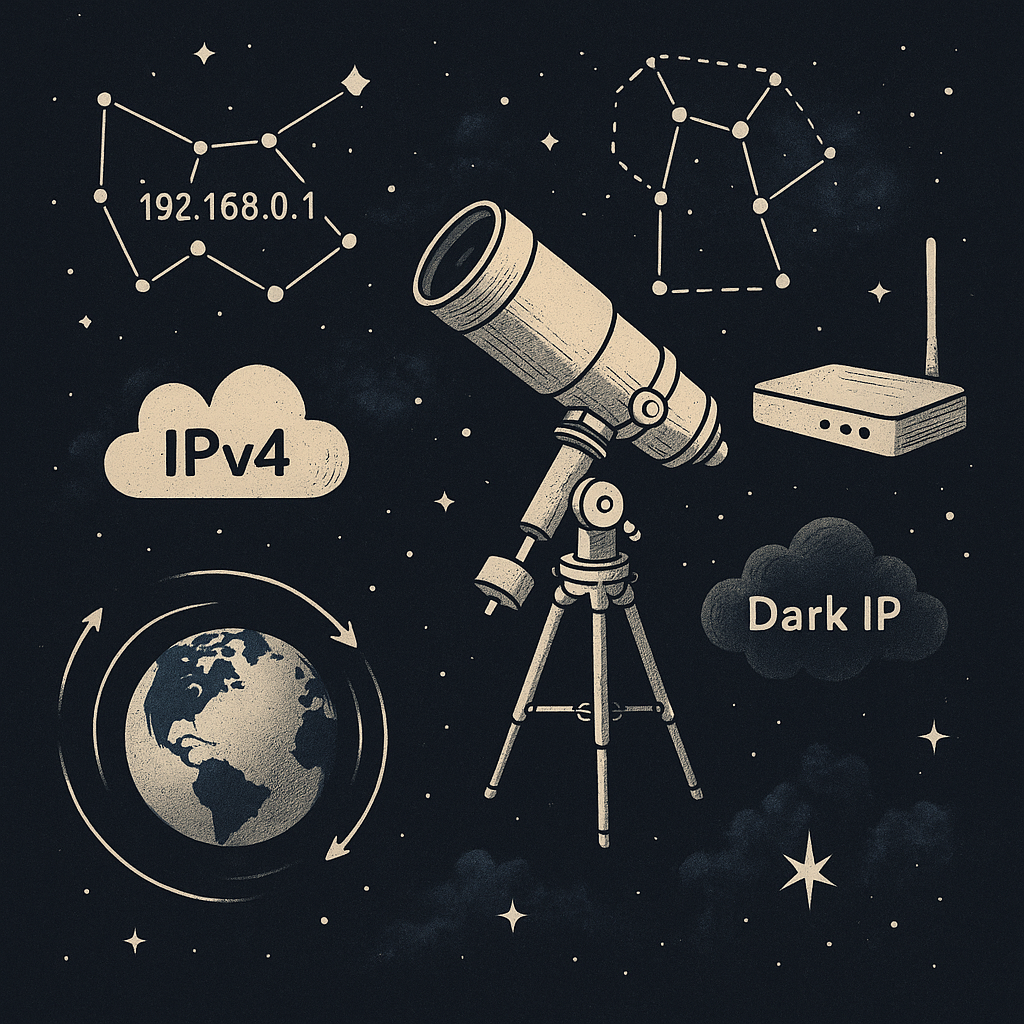🌌 IP 주소와 천문학 — 우주 좌표로 보는 인터넷의 주소
1. 하늘의 별자리 vs 인터넷의 별자리
천문학에서 별은 그냥 반짝이는 점이 아니다. 관측자가 위치를 정확히 알기 위해선 **적경(RA)과 적위(Dec)**라는 좌표가 필요하다. 마찬가지로 인터넷 세계에서도 서버나 기기를 정확히 찾기 위해 IP 주소라는 숫자 좌표가 있다. 예를 들어 ‘192.168.0.1’은 인터넷 지도 속의 별 하나다. 이 주소는 정확한 위치를 알려주지만, 하늘의 별처럼 ‘왜 거기 있는지’까지는 말해주지 않는다.
2. 망원경 포인팅과 라우팅의 닮은꼴
망원경이 특정 은하를 찾으려면 별자리 지도를 보고 각도를 맞춰야 한다. 인터넷도 비슷하다. **라우터(router)**는 IP 주소를 보고 정보의 별빛(패킷)을 최적 경로로 보낸다. 천문학자가 기기의 각도를 미세 조정하듯, 라우터도 경로를 계속 최적화해 목적지까지 신호가 안전하게 도착하게 한다.
3. IPv4, IPv6 — 관측 장비 업그레이드
천문학도 예전에는 필름 망원경만 쓰다가, CCD 카메라와 적외선 관측 장비로 발전했다. IP 주소도 초기 IPv4(약 43억 개 한정)에서 IPv6(거의 무한대 주소)로 확장됐다. 덕분에 더 많은 기기가 인터넷 하늘에 떠다닐 수 있게 됐다.
4. 서브넷 마스크 — 별자리의 경계선
천문학에서 별자리는 단순한 점들의 모음이 아니라, 관측자가 경계선을 그어 ‘이 구역은 오리온자리’라고 구분한다. 인터넷에서는 이 역할을 **서브넷 마스크(Subnet Mask)**가 한다. 예를 들어 255.255.255.0은 ‘앞 세 블록은 별자리 이름, 마지막 블록은 별의 개별 번호’처럼 구역과 세부 위치를 구분한다. 이 덕분에 망원경이 어느 구역만 집중 관측하듯, 네트워크도 필요한 구간만 효율적으로 관리할 수 있다.
5. 지구 위치 정보와 딜레이
전파망원경은 지구 반대편까지 신호를 보낼 수 있지만, 거리와 대기 상태에 따라 지연이 생긴다. 인터넷도 마찬가지다. IP 주소가 멀리 있는 서버라면 데이터가 도착하는 데 시간이 더 걸리고, 이는 핑(ping) 값으로 측정된다. 별빛이 수백 광년을 여행하듯, 패킷도 자신만의 ‘우주 여행 시간’을 가진다.
6. 보이지 않는 주소의 위험 — 다크 IP
천문학에 ‘암흑물질’이 있듯, 인터넷에도 ‘다크 IP’가 있다. 이는 공식적으로 쓰이지 않거나, 해킹에 활용되는 숨겨진 주소다. 하늘에서는 보이지 않는 질량이 중력을 만들고, 네트워크에서는 숨겨진 주소들이 데이터 흐름에 영향을 미친다.
💡 정리
IP 주소와 서브넷 마스크는 별과 별자리의 관계와 같다. 별자리가 있어야 하늘이 체계적으로 보이듯, 서브넷 마스크가 있어야 네트워크가 질서 있게 작동한다. 결국 하늘의 좌표와 인터넷 주소 체계는 모두 ‘정확한 위치를 정의하는 언어’다.
음소분석 코너
1. Orion
• 발음기호: /əˈraɪ.ən/ (미국식),
/ɒˈraɪ.ən/ (영국식)
• 뜻: 오리온자리 (겨울철 대표 별자리)
• 발음 팁: 첫 음절 /ə/는 짧게 힘을 빼고, raɪ 부분에 강세를 주며 길게. 마지막 /ən/은 ‘언’처럼 부드럽게 끝낸다.
• 음소분석:
• /ə/ 약하게 발음되는 중성모음(‘uh’)
• /r/ 혀를 말아올리는 유음
• /aɪ/ 길게 미끄러지는 이중모음 (‘아이’)
• /ən/ 비강 울림 있는 중성모음
2. segment
• 발음기호: /ˈseɡ.mənt/
• 뜻: 부분, 구획, 조각
• 발음 팁: 첫 음절 /seg/에 강세, /g/ 발음은 입 뒤쪽을 닫았다가 터뜨린다. 두 번째 /mənt/는 약하게.
• 음소분석:
• /s/ 무성 치조 마찰음
• /e/ 짧은 중전설 단모음 (bed의 e)
• /ɡ/ 유성 연구개 파열음
• /m/ 양순 비음
• /ə/ 약한 중성모음
• /n/ 치조 비음
• /t/ 무성 치조 파열음
3. specific
• 발음기호: /spəˈsɪf.ɪk/
• 뜻: 구체적인, 특정한
• 발음 팁: /spə/는 약하게 시작,
sɪf 부분에 강세. 끝의 /ɪk/는 짧고 날카롭게.
• 음소분석:
• /s/ 무성 치조 마찰음
• /p/ 무성 양순 파열음
• /ə/ 약한 중성모음
• /s/ 무성 치조 마찰음
• /ɪ/ 짧은 고전설 단모음 (sit의 i)
• /f/ 무성 순치 마찰음
• /ɪ/ 짧은 고전설 단모음
• /k/ 무성 연구개 파열음

🌌 IP Addresses and Astronomy — Internet Coordinates in the Cosmic Map
1. Star Constellations vs Internet Constellations
In astronomy, stars are not just random lights. To locate them precisely, astronomers use Right Ascension (RA) and Declination (Dec). Similarly, in the internet world, servers and devices are identified by IP addresses, which are like numeric coordinates. For example, 192.168.0.1 is a single star on the network map—it marks a spot, but not the reason for its existence.
2. Telescope Pointing and Routing
To observe a specific galaxy, a telescope must be aligned using star charts. On the internet, a router does the same—directing packets of data (starlight) along the best possible route. Just as astronomers fine-tune a telescope’s angle, routers continually optimize the path so the signal reaches its destination efficiently.
3. IPv4 and IPv6 — Upgrading the Observing Equipment
Astronomy evolved from film-based telescopes to CCD and infrared devices. IP addresses also upgraded from IPv4 (about 4.3 billion addresses) to IPv6 (virtually unlimited). This allows countless more devices to “float” in the digital sky.
4. Subnet Masks — Drawing Constellation Borders
In astronomy, constellations aren’t just clusters of stars—they’re areas marked by boundaries: “This region belongs to Orion.” In networking, the subnet mask plays this role. For example, 255.255.255.0 means “The first three blocks are the constellation name, the last block is the star’s unique number.” This allows the network to focus on a specific segment, just as a telescope targets a section of the sky.
5. Location and Delay
Radio telescopes can send signals to the other side of the Earth, but distance and atmosphere cause delays. The internet works the same way. If an IP address is far away, data takes longer to arrive, measured as ping time. Like starlight traveling for hundreds of light-years, data packets have their own “space journey time.”
6. Invisible Addresses — Dark IP
Astronomy has dark matter, and the internet has dark IPs—unused or hidden addresses often exploited for malicious purposes. In the sky, unseen mass shapes gravity; in networks, unseen addresses shape data flow.
💡 Summary
IP addresses and subnet masks are like stars and constellations. Without constellations, the sky is chaos; without subnet masks, networks lose structure. Both are languages for defining exact positions in vast spaces.